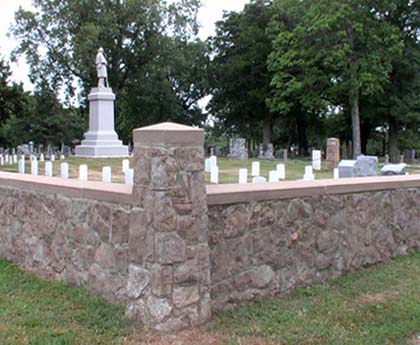|
Mound City (Woodland)Cemetery
Soldiers' Lot
Woodland Cemetery
Mound City, KS 66506
|
Office Hours:
See General Information
Visitation Hours:
Open daily from sunrise to sunset.
|
|

|
Burial Space: This soldiers' lot is closed to interments.
Acreage: 0.3
Floral/Ground Regulations
|
|
Directions from nearest airport:
From Kansas City take Interstate 29 South for 9.5 miles to Interstate 635 South. Travel Interstate 635 South 12.2 miles. Bear right onto Interstate 35 South. Travel Interstate 35 South 4.7 miles and bear right onto US 69 South. Travel US 69 South for 60 miles. Take Highway 52 West. Travel on Highway 52 West for approximately five miles to Mound City. Turn right on to North Fifth Street, which ends at the cemetery.
|
GENERAL INFORMATION
The private and community cemeteries that contain NCA soldiers' and government lots, and Confederate cemeteries, do not always have staffed offices on site. When administrative information for the larger cemetery is available, it is provided below.
This soldiers' lot is overseen by the Leavenworth National Cemetery.
Please contact the national cemetery for more information.
back to top
HISTORICAL INFORMATION
The Mound City Soldiers' Lot is located in Lots 262 and 263 of Woodland Cemetery at Mound City, Kansas, which set aside the area for the burial of soldiers. The first interments consisted of 30 Union soldiers killed in the Battles of Mine Creek and Marais des Cygnes in 1864. The deed for the soldiers' lot, measuring 48 by 158 feet, was not officially transferred until 1874. In 1888, the remains of other Union and unknown soldiers buried elsewhere in Linn County were re-interred into the soldiers' lot. In 1940, laborers of the Works Progress Administration (WPA), a depression-era work relief program, erected an enclosing stone wall and post-and-chain fence around the perimeter of the soldiers' lot.
back to top
Monuments and Memorials
In 1889, the United States erected the Union Soldiers monument to honor the 80 Civil War soldiers laid to rest at Mound City Soldiers' Lot. The granite monument, which cost approximately $2,500, depicts a Civil War infantryman holding his musket, looking to the east.
An artillery monument was placed in the soldiers' lot circa 1880.
The Linn County Historical Society erected a wooden memorial at the entrance of the soldiers' lot at some point during the 20th century. This memorial, which signified the soldiers' lot within the larger cemetery, was replaced with a limestone version in 2001.
NOTABLE PERSONS
back to top
FLORAL/GROUNDS REGULATIONS
Cemetery policies are conspicuously posted and readily visible to the public.
Floral arrangements accompanying the casket or urn at the time of burial will be placed on the completed grave. Fresh-cut flowers may be placed on graves at any time of the year. Cemetery visitors are free to use flower containers located in receptacles placed throughout the grounds. Flowers are picked up on the first and third Mondays of the month during the mowing season, April 1 through October 1.
Artificial flowers and potted plants will be permitted on graves during periods when their presence will not interfere with grounds maintenance. As a general rule, artificial flowers and potted plants will be allowed on graves for a period extending seven days before through seven days after Easter Sunday and Memorial Day.
Christmas wreaths, grave blankets and other seasonal adornments may be placed on graves from Dec. 1 through Jan. 20. They may not be secured to headstones or markers.
Permanent plantings, statues, flags, vigil lights, breakable objects, balloons, pin wheels, shepherd hooks and similar items are not permitted on the graves. The Department of Veterans Affairs does not permit adornments that are considered offensive, inconsistent with the dignity of the cemetery or considered hazardous to cemetery personnel. For example, items incorporating beads or wires may become entangled in mowers or other equipment and cause injury.
Permanent items removed from graves will be placed in an inconspicuous holding area for one month prior to disposal. Decorative items removed from graves remain the property of the donor but are under the custodianship of the cemetery. If not retrieved by donor, they are then governed by the rules for disposal of federal property.
back to top
|


